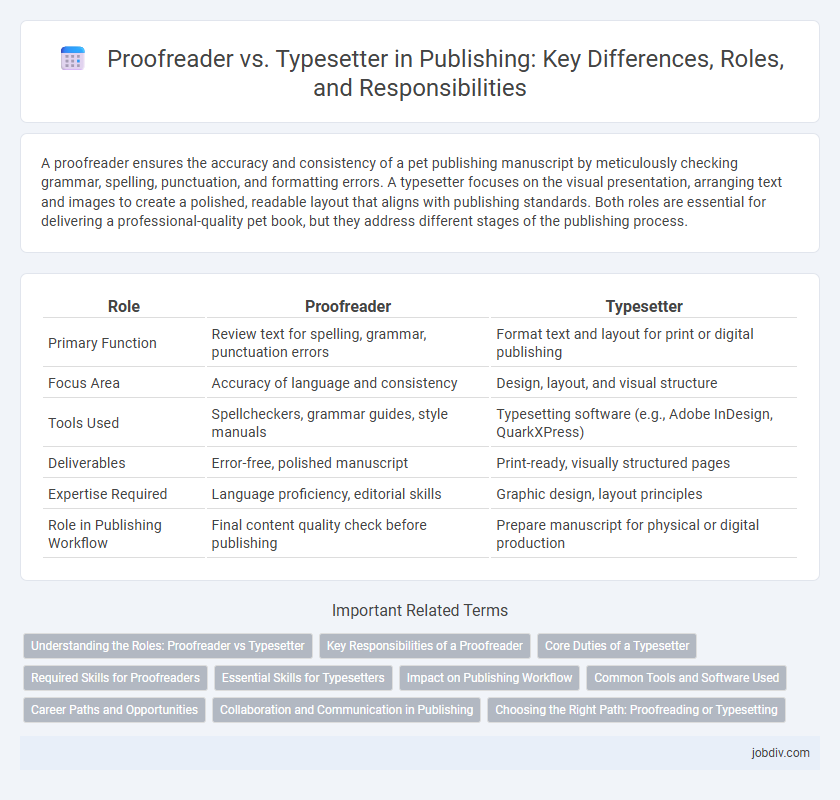A proofreader ensures the accuracy and consistency of a pet publishing manuscript by meticulously checking grammar, spelling, punctuation, and formatting errors. A typesetter focuses on the visual presentation, arranging text and images to create a polished, readable layout that aligns with publishing standards. Both roles are essential for delivering a professional-quality pet book, but they address different stages of the publishing process.
Table of Comparison
| Role | Proofreader | Typesetter |
|---|---|---|
| Primary Function | Review text for spelling, grammar, punctuation errors | Format text and layout for print or digital publishing |
| Focus Area | Accuracy of language and consistency | Design, layout, and visual structure |
| Tools Used | Spellcheckers, grammar guides, style manuals | Typesetting software (e.g., Adobe InDesign, QuarkXPress) |
| Deliverables | Error-free, polished manuscript | Print-ready, visually structured pages |
| Expertise Required | Language proficiency, editorial skills | Graphic design, layout principles |
| Role in Publishing Workflow | Final content quality check before publishing | Prepare manuscript for physical or digital production |
Understanding the Roles: Proofreader vs Typesetter
Proofreaders meticulously review manuscripts to identify and correct spelling, grammar, punctuation, and formatting errors, ensuring the text is polished and error-free before publication. Typesetters focus on arranging the text and images on the page, adjusting fonts, spacing, and layout to produce a visually appealing and readable final product. Understanding the distinct roles of proofreaders and typesetters is essential for maintaining high-quality publishing standards.
Key Responsibilities of a Proofreader
A proofreader meticulously reviews final manuscripts to identify and correct typographical errors, spelling mistakes, punctuation inaccuracies, and formatting inconsistencies before publication. Their key responsibility is ensuring textual accuracy and a polished presentation by cross-checking against style guides and author specifications. This attention to linguistic detail enhances the readability and professionalism of published content.
Core Duties of a Typesetter
A typesetter arranges text and images on a page to ensure proper layout, font selection, and spacing for print or digital publication, focusing on visual consistency and readability. They convert manuscripts into formatted pages, maintaining design specifications and preparing files for printing or distribution. Unlike proofreaders who check for grammatical errors, typesetters ensure the final presentation meets technical and aesthetic standards.
Required Skills for Proofreaders
Proofreaders require exceptional attention to detail, strong command of grammar, punctuation, and spelling, alongside the ability to spot inconsistencies and typographical errors. Proficiency with style guides such as APA, Chicago, or MLA ensures adherence to established formatting and citation standards. Effective communication skills enable proofreaders to provide clear feedback to authors and editors, facilitating the accuracy and quality of published materials.
Essential Skills for Typesetters
Typesetters require advanced skills in typography, layout design, and software proficiency in tools like Adobe InDesign and QuarkXPress to ensure accurate page formatting and visual consistency. Mastery of font selection, spacing, and alignment is crucial for producing polished publications that meet industry standards. Attention to detail and the ability to troubleshoot formatting errors are essential for delivering error-free, professional print or digital materials.
Impact on Publishing Workflow
Proofreaders ensure textual accuracy by identifying errors in grammar, spelling, and punctuation, significantly reducing the risk of costly corrections post-print. Typesetters handle the visual layout and formatting of the text, optimizing readability and aesthetic appeal, which directly impacts production speed and print quality. The collaboration between proofreaders and typesetters streamlines the publishing workflow, enhancing efficiency and ensuring the final product meets professional standards.
Common Tools and Software Used
Proofreaders commonly use tools like Microsoft Word's Track Changes, Grammarly, and PerfectIt to identify errors and ensure text accuracy. Typesetters rely on software such as Adobe InDesign, QuarkXPress, and LaTeX for layout design and formatting of printed or digital publications. Both roles may also utilize PDF editors like Adobe Acrobat for final review and adjustments before publication.
Career Paths and Opportunities
Proofreaders primarily focus on identifying and correcting grammatical, spelling, and punctuation errors to ensure text accuracy, making their skills essential in editorial and publishing firms. Typesetters specialize in arranging text and images for print or digital layout, requiring proficiency with design software and attention to visual detail, often leading to opportunities in graphic design and production departments. Both career paths offer growth in the publishing industry, with proofreaders advancing towards editorial roles and typesetters moving into digital design or publishing management positions.
Collaboration and Communication in Publishing
Effective collaboration between proofreaders and typesetters is crucial in publishing to ensure accurate text formatting and error-free content presentation. Proofreaders communicate textual corrections clearly while typesetters adjust layouts and typography to preserve the document's visual consistency. Seamless interaction between these roles enhances publication quality by minimizing errors and maintaining coherence throughout the production process.
Choosing the Right Path: Proofreading or Typesetting
Choosing the right path between proofreading and typesetting depends on your strengths and career goals within publishing. Proofreading requires a keen eye for grammar, punctuation, and consistency to ensure error-free manuscripts, while typesetting demands technical skills in layout design, typography, and software like Adobe InDesign or QuarkXPress. Understanding these distinct roles helps publishing professionals align their expertise with the industry's needs for producing polished, visually appealing publications.
Proofreader vs Typesetter Infographic

 jobdiv.com
jobdiv.com